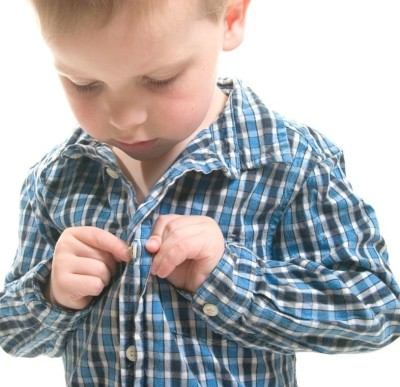
Consider whether your child is ready to learn the skill. Is the skill appropriate for their age? Or have they mastered the pre-requisite skills (e.g. if they have not yet mastered a spoon or fork in one hand, it is not appropriate to practice using a knife and fork together)?
Make practice fun, either by adapting the activity to appeal to the child’s interests or by using your enthusiasm and energy
Support motivation and use rewards (e.g. sticker charts or using preferred snacks in cutlery practice)
We all learn new skills as we move through life, and children are faced with new situations and tasks daily. It is important to support your child to develop problem-solving skills and habits. Research suggests it helps them learn better and faster and reduces dependency on others. Altering the way you teach an older child (7+) can make a huge difference.
Work on one thing at a time
- Watch your child carry out a task (e.g. handwriting or putting shoes on)
- Identify where their areas of difficulty are (e.g. letter formation or putting their foot in their shoe without folding down the back with their heel)
- Break the task down into small achievable steps (e.g. work on correctly forming one letter at a time, then 2-3 letter words, working towards a sentence or begin to practice with slip-on shoes or shoes that are too big)
Ask, don’t tell. Formulate questions and do not give direct instructions. Ask, “What does the letter ‘a’ look like?”. Or “What could you do to make the space for your foot bigger?”.
Resist the temptation to instruct. Keep questions focussed on the activity.
Coach, don’t adjust. Resist the temptation to be ‘hands-on’. Verbally guide your child to reach a solution.
Use your child’s words. If your child describes the letter ‘b’ as a stick and ball, then frame your questions using this language, e.g. “What other letters have a stick and ball?”. If your child rushes when putting shoes on, and describes it as being as fast as a cheetah, ask “How would a snail put on their shoes?”
Stay in sync. New knowledge is constructed from existing knowledge. What other letters start like the letter ‘c’? How do you put your wellies on?
Practise and repetition improve performance. The more the better! Begin with short bursts throughout the week, working towards practising every day.
Promote individuality, do not change what works.
Do it together. Your role, as a parent or teacher, is to support your child through the problem-solving process. Avoid direct skill training (which we know is quicker), instead guide your child to discover possible solutions to their problem.
Think: Goal - Plan - Do - Check
GOAL
First, when teaching your child to problem-solve, ensure they know what you’re expecting of them, i.e. ‘what is the goal? (each small achievable step is an individual goal).
E.g. to form all letters in the child’s name using the correct starting point, or to put foot in one shoe without folding down the back.
PLAN
Next, make a plan. Ask your child how are they going to achieve their goal? Try one plan at a time. If your child is struggling, ask them questions and form a plan together.
E.g. to copy from a prompt sheet that shows the starting points, or to hold the back of the shoe while they put their foot in.
DO- Then, do it. Ask your child to show you their plan, give them time.
CHECK
Now, check to see if their plan worked.
- Yes? Great working out to find a solution that works! What’s the next goal to work on?
- No? Let’s make a new plan, do it and check again
When a child finds something difficult we often let them begin and then take over when they are struggling and finish the task for them. This can be challenging and frustrating for the child.
An alternative shown to be very effective for self-care skills is to flip the process around, we call this ‘backward chaining’. Backward chaining teaches skills by breaking the task into steps. The adult assists with the initial steps and lets the child finish the final steps. Children who have the opportunity to learn and practice a skill have the satisfaction of completing the task and experience success. This means they are more likely to try again and keep practising!
How do I do it?
Think about the different steps in a task. What is the last step?
Examples:
Putting on a t-shirt:
- Pull shirt over head
- Push right arm up through right sleeve
- Push left arm up through left sleeve
- Pull shirt down to waist
Putting on trousers
- Hold trousers by the waistband
- Find the label at the back
- Lower trousers
- Lift one leg into a hole
- Put the other leg into the second hole.
- Pull trousers up to knees
- Stand up and pull your trousers up to the waist.
Bottom wiping
- Taking paper
- folding paper
- wiping
- checking if clean
- putting the paper into the toilet
- (repeat if necessary)
-
Flush the toilet